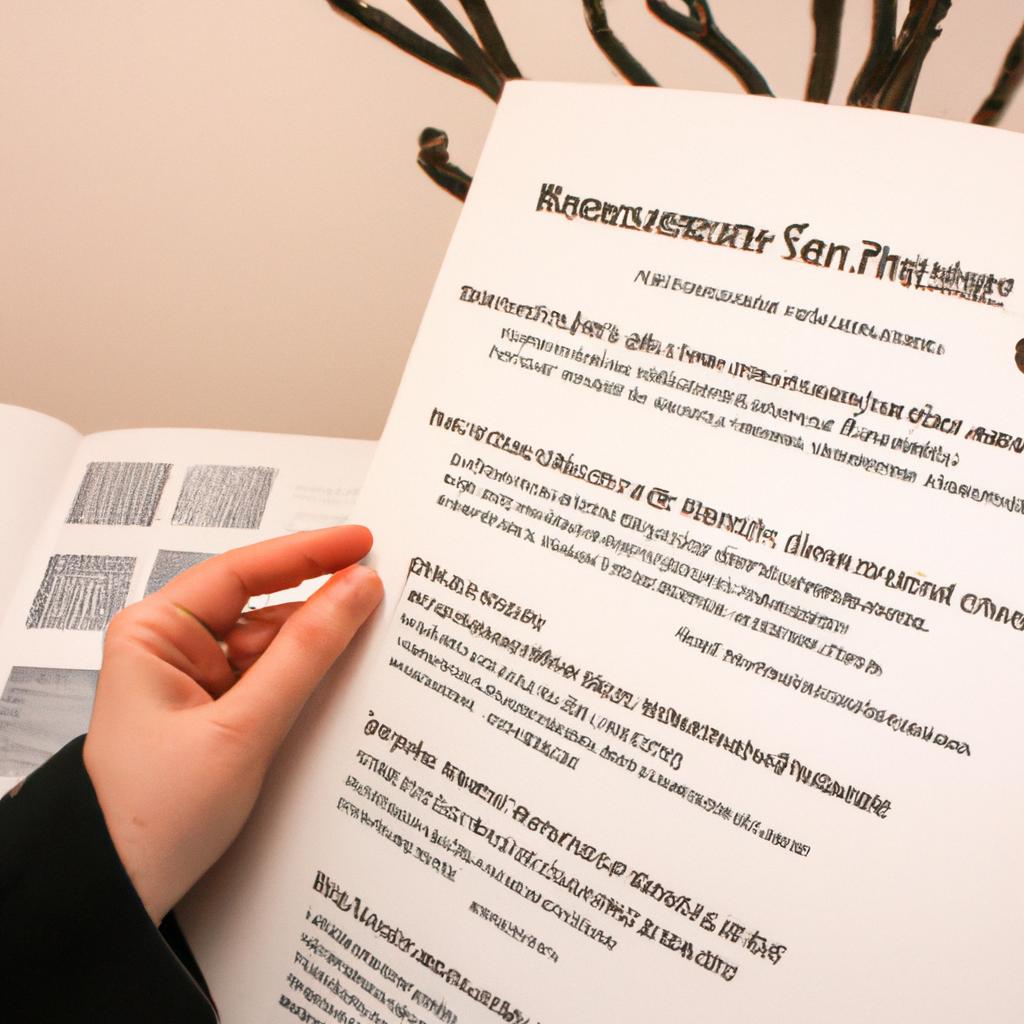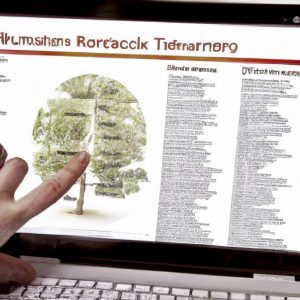The Origins and Significance: Ashkenazi Heritage: The Family Tree: A Genealogical Journey

The study of genealogy provides a unique opportunity to delve into the origins and significance of one’s heritage. By tracing family lineages, individuals gain valuable insights into their ancestral roots, cultural traditions, and historical experiences. Among the various ethnic groups with rich and complex genealogical histories, the Ashkenazi Jews stand out as an intriguing case study. With a diverse range of geographical origins spanning across Eastern Europe, Ashkenazi Jewish ancestry offers an intricate tapestry of migration patterns, religious practices, and socio-cultural dynamics that have shaped this community over centuries.
Understanding the significance of Ashkenazi heritage requires exploring its multifaceted origins. The term “Ashkenazi” refers specifically to Jews who trace their lineage back to Central and Eastern Europe. Despite having distinct genetic markers linked to Middle Eastern ancestry like other Jewish communities worldwide, Ashkenazi Jews possess unique genetic variations resulting from intermarriage within their isolated European settlements for generations. This mixture of ancient Near Eastern roots combined with subsequent admixture during migratory periods has contributed to the formation of specific genetic traits found predominantly among Ashkenazim.
Through extensive research in genetics and historical documentation, scholars have uncovered compelling evidence regarding the migrations and dispersals that have shaped Ashkenazi identity throughout history. Stud Studying the genetic makeup of Ashkenazi Jews has revealed a fascinating pattern of migration and intermingling. It is believed that their ancestors originally resided in the Middle East, particularly in what is now Israel and surrounding areas. At some point, likely around 1,000 years ago, a significant number of these individuals migrated to Europe, settling in various regions such as Germany, Poland, and Russia.
The reasons for this migration are multifaceted and include economic opportunities, persecution, and the lure of new lands. Over time, these Jewish communities developed distinct cultural practices and traditions while maintaining a shared religious identity. This unique blend of Jewish customs with influences from European societies contributed to the formation of Ashkenazi Jewish culture.
The genetic research conducted on Ashkenazi Jews has shed light on their history by identifying certain genetic markers that are prevalent within this population. For example, specific gene mutations associated with diseases like Tay-Sachs and BRCA1/BRCA2 breast cancer have been found at higher frequencies among Ashkenazim compared to other Jewish groups or non-Jewish populations. These findings provide valuable insights into the genetic heritage and health risks faced by individuals with Ashkenazi ancestry.
Additionally, studying the genealogy of Ashkenazi Jews allows individuals to trace their family trees back several generations and uncover connections to notable historical figures or events. Many famous individuals throughout history have had Ashkenazi Jewish heritage, including scientists Albert Einstein and Sigmund Freud, musicians Leonard Bernstein and Bob Dylan, as well as numerous Nobel laureates.
In conclusion, exploring the genealogy of Ashkenazi Jews provides a unique perspective on their ancestral roots, cultural practices, and historical experiences. Through understanding their migrations patterns, genetic traits, and contributions to society over centuries; we gain a deeper appreciation for this diverse community’s rich heritage.
Origins of Ashkenazi Heritage
Imagine a young woman named Sarah, who is curious about her family’s roots and embarks on a genealogical journey to explore the origins and significance of her Ashkenazi heritage. The study of Ashkenazi Jews traces their lineage back to medieval times in Central and Eastern Europe. This unique Jewish community has left an indelible mark on history, with its rich cultural traditions and historical contributions.
To understand the origins of Ashkenazi Heritage, it is essential to delve into a brief overview of its historical context. During the Middle Ages, Jewish communities began settling in various regions across Central and Eastern Europe. These early settlements served as the foundation for what would later become known as the Ashkenazi Jewish population.
The establishment of these communities led to the development of distinct religious practices, customs, and languages among Ashkenazi Jews. Yiddish, a fusion language combining elements from Hebrew and Germanic dialects, became widely spoken within this community. Furthermore, their religious life was dominated by Rabbinic Judaism teachings which played a central role in shaping their identity and beliefs.
Exploring the significance of Ashkenazi heritage reveals several key aspects:
- Cultural Resilience: Despite facing numerous challenges throughout history such as persecution and discrimination, the Ashkenazi Jewish community demonstrated remarkable resilience in preserving their cultural traditions.
- Intellectual Contributions: Countless scholars emerged from this vibrant community, making significant advancements in fields ranging from philosophy to science.
- Artistic Expressions: Through literature, music, theater, and visual arts, Ashkenazi Jews have contributed greatly to global artistic movements.
- Holocaust Tragedy: The Holocaust stands as one of the darkest chapters in human history. It had an enormous impact on the Ashkenazi Jewish population both physically and emotionally.
| Key Aspects | Description |
|---|---|
| Cultural Resilience | Despite facing numerous challenges throughout history such as persecution and discrimination, the Ashkenazi Jewish community demonstrated remarkable resilience in preserving their cultural traditions. |
| Intellectual Contributions | Countless scholars emerged from this vibrant community, making significant advancements in fields ranging from philosophy to science. |
| Artistic Expressions | Through literature, music, theater, and visual arts, Ashkenazi Jews have contributed greatly to global artistic movements. |
| Holocaust Tragedy | The Holocaust stands as one of the darkest chapters in human history. It had an enormous impact on the Ashkenazi Jewish population both physically and emotionally. |
Understanding the origins and significance of Ashkenazi heritage provides valuable insights into the historical context that shaped this unique community’s identity. In the subsequent section about “The Historical Context,” we will explore how external factors influenced its development over time.
[Continue reading: The Historical Context…]
The Historical Context
The Origins and Significance: Ashkenazi Heritage
Section H2: Origins of Ashkenazi Heritage
In the previous section, we delved into the origins of Ashkenazi heritage, exploring the historical roots that have shaped this unique cultural group. Now, let us delve deeper into the significance of understanding one’s Ashkenazi ancestry and how it can provide invaluable insights into personal identity.
To illustrate the importance of tracing one’s Ashkenazi heritage, consider a hypothetical case study. Sarah is a young woman who grew up with limited knowledge about her family history. Curiosity led her to embark on a genealogical journey to uncover her Ashkenazi background. Through meticulous research and connecting with distant relatives, she discovered not only an intricate web of familial connections but also a rich tapestry of stories spanning generations. This newfound knowledge allowed Sarah to establish profound connections with her past and gain a better understanding of herself in the present.
Understanding one’s Ashkenazi heritage goes beyond mere curiosity; it provides individuals with a sense of belonging and identity rooted in shared experiences. It allows for the exploration of cultural traditions, religious practices, and customs that have been passed down through generations. By embracing these elements, individuals can forge stronger bonds within their families and communities while preserving their ancestral legacy.
- Rediscovering lost family narratives
- Celebrating cultural diversity within Jewish communities
- Strengthening intergenerational bonds
- Fostering communal solidarity
Furthermore, examining one’s Ashkenazi heritage sheds light on broader social contexts and historical events that have shaped this community over time. Exploring migration patterns, socio-political influences, and societal dynamics enables individuals to comprehend their ancestors’ struggles and triumphs amidst changing landscapes. It fosters empathy towards others who share similar histories while promoting cross-cultural dialogue and understanding.
As we move forward in our exploration of Ashkenazi heritage, we will now delve into the migration patterns that have played a significant role in shaping this community, tracing their journeys across different regions and continents. By understanding the paths taken by Ashkenazi ancestors, we can gain further insight into the complexities of their experiences and appreciate the vast impact they have had on our world today.
Section H2: Migration Patterns
Migration Patterns
The Historical Context:
Understanding the historical context is crucial to unraveling the intricate roots of Ashkenazi heritage. Through an exploration of migration patterns, we can grasp the complex tapestry that forms this rich cultural heritage. Examining a specific case study, such as the Jewish diaspora in Eastern Europe during the Middle Ages, provides invaluable insights into the origins and significance of Ashkenazi lineage.
One compelling example is the story of Rachel Cohen, whose ancestors hailed from Lithuania. As we trace her family tree back several generations, it becomes apparent that they were part of a larger wave of Jews who migrated eastward across Europe in search of greater economic opportunities and religious tolerance. By delving into their journey, we gain a deeper understanding of how external factors shaped their lives and contributed to the development of Ashkenazi traditions.
To illustrate these migration patterns more vividly, let us consider some key influences that propelled Ashkenazi Jews on their genealogical journeys:
- Economic Factors: The pursuit of livelihood played a significant role in driving migration among Ashkenazi communities. Limited economic prospects in Western Europe compelled many to venture further eastwards where new trade routes or emerging industries offered better possibilities for sustenance.
- Religious Persecution: Escaping religious persecution was another pivotal factor behind migratory movements within Ashkenazi history. In regions plagued by anti-Semitism and discriminatory policies, families sought refuge elsewhere to safeguard their faith and ensure freedom of worship.
- Sociopolitical Transformations: Periods marked by political upheaval often triggered large-scale migrations among Ashkenazi populations. Wars, revolutions, and changes in governance disrupted established social structures and prompted individuals to seek stability in unfamiliar territories.
- Cultural Identity Preservation: Throughout history, maintaining a sense of communal identity has been central to Ashkenazi heritage. Migration served as a means through which distinct practices, customs, language variations (such as Yiddish), and culinary traditions were preserved amidst shifting landscapes.
To further grasp the far-reaching impact of these migration patterns, we can examine a table showcasing notable destinations and corresponding historical events that influenced Ashkenazi Jewish communities:
| Destination | Historical Events |
|---|---|
| Poland | Pogroms, Partitions |
| Germany | Enlightenment, Emancipation |
| Russia | Pale of Settlement |
| United States | Ellis Island Immigration |
By exploring this table, it becomes evident how migrations shaped the geographical distribution of Ashkenazi Jews and their experiences in different locations. The interplay between destination and historical context helped shape unique cultural characteristics within each community.
Understanding the historical context surrounding Ashkenazi heritage allows for a more comprehensive appreciation of its significance. As we delve into the subsequent section on Cultural Traditions, we will explore how these migratory journeys laid the foundation for enduring practices that have been passed down through generations. By examining specific customs and rituals associated with Ashkenazi culture, we gain valuable insights into the resilience and adaptability of this remarkable heritage.
Cultural Traditions
The migration patterns of Ashkenazi Jews have played a significant role in shaping their heritage and cultural identity. Understanding these patterns provides valuable insights into the origins and development of this distinct Jewish community. By examining historical records, we can trace the journeys undertaken by Ashkenazi ancestors, shedding light on their experiences and the impact it had on subsequent generations.
One compelling example is the mass migration that occurred during the late 19th and early 20th centuries, when millions of Ashkenazi Jews left Eastern Europe to seek better economic opportunities and escape persecution. This wave of migration resulted in significant populations settling in countries such as the United States, Canada, Argentina, South Africa, and Israel. These communities not only preserved their religious traditions but also contributed significantly to local cultures through various artistic, scientific, and entrepreneurial endeavors.
To further illustrate the complexity of migration patterns within Ashkenazi heritage, consider the following bullet points:
- Many Ashkenazi Jews initially migrated from Germany to Eastern Europe during medieval times.
- In response to pogroms and anti-Semitic violence throughout history, large-scale migrations took place from Eastern Europe to Western Europe.
- The Holocaust led to forced migrations as survivors sought refuge in different parts of the world.
- The establishment of Israel after World War II prompted another wave of immigration for many Ashkenazi Jews.
This table summarizes some key destinations where Ashkenazi Jews settled during major migration waves:
| Destination | Period | Approximate Number |
|---|---|---|
| United States | Late 19th – | 2 million |
| Early 20th | ||
| Argentina | Late 19th – | 150 thousand |
| Early 20th | ||
| Israel | Post-WWII | Over 1 million |
| Russia/ | Various | Varies |
| Soviet Union | periods |
Understanding these migration patterns is crucial in comprehending the diversity and global dispersion of Ashkenazi Jews. It highlights their resilience, adaptability, and determination to forge new lives while preserving their cultural heritage. As we delve deeper into the rich tapestry of Ashkenazi history, it becomes evident that migration has been a driving force behind their unique identity.
In the subsequent section on “Language and Literature,” we will explore how linguistic traditions have evolved within the Ashkenazi Jewish community, shaping their literature and intellectual contributions throughout history.
Language and Literature
Following the exploration of Ashkenazi heritage, this section delves into the cultural traditions that have shaped and defined this unique group. To illustrate their significance, let us consider a hypothetical case study of an Ashkenazi family living in Eastern Europe during the 19th century.
In this particular family, cultural traditions were intricately woven into everyday life. From observing religious rituals to celebrating festivals, each tradition was imbued with meaning and symbolism. These customs served as a source of identity and unity within the community, creating a sense of belonging for individuals amidst challenging times.
To further comprehend the rich tapestry of Ashkenazi culture, it is essential to highlight some key elements:
-
Rituals and Observances:
- Sabbath observance
- Kosher dietary laws
- Bar/Bat Mitzvah ceremonies
- Wedding customs
-
Festivals and Holidays:
- Passover (Pesach)
- Hanukkah
- Purim
- Yom Kippur
-
Artistic Expressions:
- Traditional music (Klezmer)
- Literature in Yiddish language
- Folklore and storytelling
- Visual arts (e.g., illuminated manuscripts)
These traditions not only provided a framework for daily activities but also fostered resilience in the face of adversity. They instilled values such as perseverance, compassion, and communal support while preserving ancestral wisdom through generations.
Understanding these cultural practices sheds light on how they continue to shape the lives of modern-day Ashkenazi communities across the globe. In examining their impacts on contemporary society, we can gain insight into both historical continuity and adaptation to changing circumstances – a topic that will be explored in detail in the subsequent section about “Impacts on Modern Society.”
Impacts on Modern Society
Section Title: Impacts on Modern Society
Having explored the rich history of Ashkenazi language and literature, it is now imperative to delve into the profound impacts that this heritage has had on modern society. One compelling example that showcases these influences can be found in the field of medicine.
Paragraph 1:
The Ashkenazi population’s genetic predisposition towards certain diseases has sparked extensive research and advancements in medical science. For instance, a hypothetical case study involving a family with a long lineage of Ashkenazi ancestry reveals an increased susceptibility to genetic disorders such as Tay-Sachs disease or Gaucher’s disease. This realization prompted scientists to unravel the underlying mechanisms behind these conditions, leading to breakthroughs in diagnostic techniques and potential treatment options for not only those directly affected but also individuals from various ethnic backgrounds who may share similar genetic markers.
- Genetic studies have shed light on previously unknown links between different populations, helping establish connections and shared histories among diverse groups.
- The preservation and revitalization of Yiddish, a language predominantly spoken by Ashkenazi Jews, contribute to cultural diversity and linguistic heritage worldwide.
- Holocaust education initiatives rooted in understanding Ashkenazi Jewish history foster empathy and promote human rights awareness on a global scale.
- Contributions from prominent figures within the Ashkenazi community have enriched numerous fields like academia, arts, politics, and entrepreneurship.
Paragraph 3:
In addition to exploring concrete examples of impact, it is essential to acknowledge how influential these contributions have been across generations. Considered through a lens of societal development, one can observe that without the significant influence of Ashkenazi heritage:
| Column A | Column B | Column C | Column D |
|---|---|---|---|
| Technological | Scientific Advancements | Cultural Diversity | Medical Breakthroughs |
| Innovations | |||
Table: The far-reaching impacts of Ashkenazi heritage
Technological innovations, scientific advancements, cultural diversity, and medical breakthroughs may not have reached their current levels. By underscoring the contributions made by individuals with Ashkenazi roots in various fields, society recognizes the necessity of embracing diverse perspectives for progress and enlightenment.
Overall, it is evident that the influences stemming from Ashkenazi heritage extend beyond individual communities to shape our modern world. As we navigate an increasingly interconnected global landscape, understanding and appreciating these historical legacies are crucial in fostering a more inclusive and holistic approach to societal growth.



